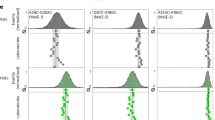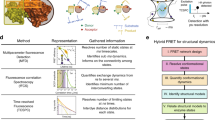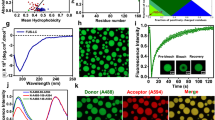Abstract
A large range of debilitating medical conditions1 is linked to protein misfolding, which may compete with productive folding particularly in proteins containing multiple domains2. Seventy-five per cent of the eukaryotic proteome consists of multidomain proteins, yet it is not understood how interdomain misfolding is avoided. It has been proposed that maintaining low sequence identity between covalently linked domains is a mechanism to avoid misfolding3. Here we use single-molecule Förster resonance energy transfer4,5 to detect and quantify rare misfolding events in tandem immunoglobulin domains from the I band of titin under native conditions. About 5.5 per cent of molecules with identical domains misfold during refolding in vitro and form an unexpectedly stable state with an unfolding half-time of several days. Tandem arrays of immunoglobulin-like domains in humans show significantly lower sequence identity between neighbouring domains than between non-adjacent domains3. In particular, the sequence identity of neighbouring domains has been found to be preferentially below 40 per cent3. We observe no misfolding for a tandem of naturally neighbouring domains with low sequence identity (24 per cent), whereas misfolding occurs between domains that are 42 per cent identical. Coarse-grained molecular simulations predict the formation of domain-swapped structures that are in excellent agreement with the observed transfer efficiency of the misfolded species. We infer that the interactions underlying misfolding are very specific and result in a sequence-specific domain-swapping mechanism. Diversifying the sequence between neighbouring domains seems to be a successful evolutionary strategy to avoid misfolding in multidomain proteins.
This is a preview of subscription content, access via your institution
Access options
Subscribe to this journal
Receive 51 print issues and online access
$199.00 per year
only $3.90 per issue
Buy this article
- Purchase on Springer Link
- Instant access to full article PDF
Prices may be subject to local taxes which are calculated during checkout




Similar content being viewed by others
References
Gregersen, N., Bross, P., Vang, S. & Christensen, J. H. Protein misfolding and human disease. Annu. Rev. Genomics Hum. Genet. 7, 103–124 (2006)
Jaenicke, R. & Seckler, R. Protein misassembly in vitro . Adv. Protein Chem. 50, 1–59 (1997)
Wright, C. F., Teichmann, S. A., Clarke, J. & Dobson, C. M. The importance of sequence diversity in the aggregation and evolution of proteins. Nature 438, 878–881 (2005)
Joo, C., Balci, H., Ishitsuka, Y., Buranachai, C. & Ha, T. Advances in single-molecule fluorescence methods for molecular biology. Annu. Rev. Biochem. 77, 51–76 (2008)
Schuler, B. & Eaton, W. A. Protein folding studied by single-molecule FRET. Curr. Opin. Struct. Biol. 18, 16–26 (2008)
Fedorov, A. N. & Baldwin, T. O. Cotranslational protein folding. J. Biol. Chem. 272, 32715–32718 (1997)
Li, H. et al. Reverse engineering of the giant muscle protein titin. Nature 418, 998–1002 (2002)
Borgia, A., Williams, P. M. & Clarke, J. Single-molecule studies of protein folding. Annu. Rev. Biochem. 77, 101–125 (2008)
Oberhauser, A. F., Marszalek, P. E., Carrion-Vasquez, M. & Fernandez, J. M. Single protein misfolding events captured by atomic force microscopy. Nature Struct. Biol. 6, 1025–1028 (1999)
Stryer, L. Fluorescence energy transfer as a spectroscopic ruler. Annu. Rev. Biochem. 47, 819–846 (1978)
Gambin, Y. et al. Direct single-molecule observation of a protein living in two opposed native structures. Proc. Natl Acad. Sci. USA 106 10153–10158 (2009) CrossRef
Fowler, S. B. & Clarke, J. Mapping the folding pathway of an immunoglobulin domain: structural detail from phi value analysis and movement of the transition state. Structure 9, 355–366 (2001)
Hofmann, H. et al. Single-molecule spectroscopy of protein folding in a chaperonin cage. Proc. Natl Acad. Sci. USA 107, 11793–11798 (2010)
Ivarsson, Y., Travaglini-Allocatelli, C., Brunori, M. & Gianni, S. Folding and misfolding in a naturally occurring circularly permuted PDZ domain. J. Biol. Chem. 283, 8954–8960 (2008)
Gianni, S. et al. Structural characterization of a misfolded intermediate populated during the folding process of a PDZ domain. Nature Struct. Mol. Biol. 17, 1431–1437 (2010)
Korzhnev, D. M., Religa, T. L., Banachewicz, W., Fersht, A. R. & Kay, L. E. A transient and low-populated protein-folding intermediate at atomic resolution. Science 329, 1312–1316 (2010)
Capaldi, A. P., Kleanthous, C. & Radford, S. E. Im7 folding mechanism: misfolding on a path to the native state. Nature Struct. Biol. 9, 209–216 (2002)
Yang, S. et al. Domain swapping is a consequence of minimal frustration. Proc. Natl Acad. Sci. USA 101, 13786–13791 (2004)
Arora, P., Hammes, G. G. & Oas, T. G. Folding mechanism of a multiple independently-folding domain protein: double B domain of protein A. Biochemistry 45, 12312–12324 (2006)
Jaenicke, R. Folding and association of proteins. Prog. Biophys. Mol. Biol. 49, 117–237 (1987)
Straub, J. E. & Thirumalai, D. Principles governing oligomer formation in amyloidogenic peptides. Curr. Opin. Struct. Biol. 20, 187–195 (2010)
Bennett, M. J., Sawaya, M. R. & Eisenberg, D. Deposition diseases and 3D domain swapping. Structure 14, 811–824 (2006)
Mitraki, A. Protein aggregation from inclusion bodies to amyloid and biomaterials. Adv. Protein Chem. Struct. Biol. 79, 89–125 (2010)
Borgia, A., Steward, A. & Clarke, J. An effective strategy for the design of proteins with enhanced mechanical stability. Angew. Chem. Int. Ed. 47, 6900–6903 (2008)
Balamurali, M. M. et al. Recombination of protein fragments: a promising approach toward engineering proteins with novel nanomechanical properties. Protein Sci. 17, 1815–1826 (2008)
Lu, H., Isralewitz, B., Krammer, A., Vogel, V. & Schulten, K. Unfolding of titin immunoglobulin domains by steered molecular dynamics simulation. Biophys. J. 75, 662–671 (1998)
Brooks, B. R. et al. CHARMM: A program for macromolecular energy, minimization, and dynamics calculations. J. Comput. Chem. 4, 187–217 (1983)
Dahan, M. et al. Ratiometric measurement and identification of single diffusing molecules. Chem. Phys. 247, 85–106 (1999)
Scott, K. A., Steward, A., Fowler, S. B. & Clarke, J. Titin; a multidomain protein that behaves as the sum of its parts. J. Mol. Biol. 315, 819–829 (2002)
Steward, A., Toca-Herrera, J. L. & Clarke, J. Versatile cloning system for construction of multimeric proteins for use in atomic force microscopy. Protein Sci. 11, 2179–2183 (2002)
Schuler, B., Lipman, E. A. & Eaton, W. A. Probing the free-energy surface for protein folding with single-molecule fluorescence spectroscopy. Nature 419, 743–747 (2002)
Nettels, D. et al. Single-molecule spectroscopy of the temperature-induced collapse of unfolded proteins. Proc. Natl Acad. Sci. USA 106, 20740–20745 (2009)
Hillger, F., Nettels, D., Dorsch, S. & Schuler, B. Detection and analysis of protein aggregation with confocal single molecule fluorescence spectroscopy. J. Fluoresc. 17, 759–765 (2007)
Schuler, B. Application of single molecule Förster resonance energy transfer to protein folding. Protein Folding Protocols (eds Bai, Y. & Nussinov, R.) 115–138 (Humana Press, 2007)
Hoffmann, A. et al. Mapping protein collapse with single-molecule fluorescence and kinetic synchrotron radiation circular dichroism spectroscopy. Proc. Natl Acad. Sci. USA 104, 105–110 (2007)
Improta, S., Politou, A. S. & Pastore, A. Immunoglobulin-like modules from titin I-band: extensible components of muscle elasticity. Structure 4, 323–337 (1996)
Karanicolas, J. & Brooks, C. L., III Improved Go-like models demonstrate the robustness of protein folding mechanisms towards non-native interactions. J. Mol. Biol. 334, 309–325 (2003)
Acknowledgements
This work was supported by the Wellcome Trust (grant number, 064417), the Swiss National Science Foundation (to B.S.) and the Swiss National Center of Competence in Research in Structural Biology (to B.S.). M.B.B. was supported by a UK Medical Research Council studentship. A.B. is supported by a Marie Curie Intra-European Fellowship. R.B.B. is supported by a Royal Society University Research Fellowship. J.C. is a Wellcome Trust Senior Research Fellow. We thank H. Hofmann, A. Soranno and A. Hoffmann for discussions and contributions to data analysis.
Author information
Authors and Affiliations
Contributions
M.B.B., A.B., B.S. and J.C. designed the investigation. M.B.B. and A.B. performed the experiments. R.B.B. performed the simulations. D.N. and B.W. built the single-molecule instrumentation. D.N. provided data analysis software. A.S. cloned the gene of the trimeric tandem construct. M.B.B. performed the analysis. M.B.B., J.C. and B.S. wrote the paper.
Corresponding authors
Ethics declarations
Competing interests
The authors declare no competing financial interests.
Supplementary information
Supplementary Information
The file contains Supplementary Methods, Supplementary Table 1, Supplementary Figures 1-9 with legends and additional references. (PDF 8146 kb)
Rights and permissions
About this article
Cite this article
Borgia, M., Borgia, A., Best, R. et al. Single-molecule fluorescence reveals sequence-specific misfolding in multidomain proteins. Nature 474, 662–665 (2011). https://doi.org/10.1038/nature10099
Received:
Accepted:
Published:
Issue Date:
DOI: https://doi.org/10.1038/nature10099
This article is cited by
-
Mechanisms and pathology of protein misfolding and aggregation
Nature Reviews Molecular Cell Biology (2023)
-
Designed folding pathway of modular coiled-coil-based proteins
Nature Communications (2021)
-
Interactions between nascent proteins and the ribosome surface inhibit co-translational folding
Nature Chemistry (2021)
-
Bacterial Hsp70 resolves misfolded states and accelerates productive folding of a multi-domain protein
Nature Communications (2020)
-
A HaloTag-TEV genetic cassette for mechanical phenotyping of proteins from tissues
Nature Communications (2020)
Comments
By submitting a comment you agree to abide by our Terms and Community Guidelines. If you find something abusive or that does not comply with our terms or guidelines please flag it as inappropriate.



